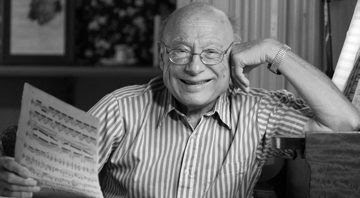
Although his contribution to the clarinet world is not well known outside his hometown of New York City, the composer and clarinetist Harold Seletsky (1927-2010) wrote hundreds of works for the instrument in styles ranging from avant-garde to klezmer.
His haunting unaccompanied quarter-tone solos showcase his idiosyncratic use of a 24-tone scale and his Concertino for Klezmer Clarinet and String Quartet won first prize in the American Society for Jewish Music’s 1998 International New Music Competition. Harold studied composition with Josef Schmidt, a prize student of Alban Berg, who came to this country to escape the Nazi’s. In the Old World tradition of apprenticeship learning (vs. the university system) the dozen or so students in Schmidt’s studio learned the craft of composition using Arnold Schoenberg’s meticulous pedagogical system.
By the late 1950’s Harold was writing multi-movement works in the 12-tone system including his Sonata for Clarinet and Piano, recorded here at Symphony Space in 2010 – Seletsky Sonata. He eventually abandoned Schoenberg’s 12-tone system in favor of the 24-tone scale. His love of quarter-tones informed many of his compositions from avant-garde chamber works to klezmer freylekhs (Robin’s Piece).
Here is the first of four tutorials I created showing every quarter-tone fingering available on the clarinet based on what he taught me Learn Clarinet Quarter-Tones #1
By the mid-1960s, with a family to support, Harold pursued a career on
Madison Ave. working for advertising agencies writing commercial jingles
and film music. Most notable in this arena was the theme for the long
running TV news program “Issues and Answers” and campaigns for US
Steel, Air France, Gimbels, Royal Jordanian Airlines and Royal Air Maroc. As a little kid, it was always a thrill to be watching TV and hear his music
during a commercial break!
Despite his success, however, he was never fulfilled by this turn his career had taken. He very much felt as if he had “sold out”. Jingles and commercial work was the antithesis of the music of Bach, Beethoven and Brahms – the deep and profound music that spoke to him so passionately. By his later years he was finally able to be free of the need to compose solely for money and got out of the commercial world once and for all.

There was so much more to Harold’s musical life, however, than formal composition. Having grown up dirt poor in Williamsburg, Brooklyn during the Depression, his first paying jobs were playing “club dates” in the Borscht Belt hotels in the Catskill Mountains.
He, of course, respected the musicianship of Benny Goodman but it was Artie Shaw’s style that had the bigger influence on him. In addition to being steeped in the 1940’s swing style, Harold was shaped first and foremost by the music he heard growing up – Yiddish folk music now referred to as Klezmer but simply called back then “Jewish”. If you were “Playing Jewish” on a club date it meant the portion of the gig where the familiar shers, bulgars and freylekhs were performed to the delight of the Yiddish speaking guests at a wedding or show.
During the klezmer revival begun in the 1990’s, Harold revisited that genre but with a newly formed ensemble, The West End Klezmorim, so named because they had a standing gig at Art Lugoff’s West End Gate. Coming full circle, Harold now wrote scores of Jewish inspired compositions including klezmer tunes, songs, nigunim, a full Shabbat service and more.
Last but not least, he was not content to limit his jazz playing to the Big
Band style of the ’40’s. He was tireless in his quest to grow as an instrumentalist, incorporating progressive harmonies into his clarinet improvisations and always trying to learn from the young and adventurous players with whom he surrounded himself.
This tribute to my Dad’s musical life barely scratches the surface. I’ve left out his years of “legit” clarinet playing: his studies with Gino Cioffi of the
Boston Symphony (searching for the most beautiful sound possible), playing Eb Clarinet in the Houston Symphony under Leopold Stokowski, his transcriptions for clarinet and string quartet of the Schumann Fantasy Pieces, Bach Chaconne, both clarinet sonatas by Brahms – all pieces he not only loved but loved the idea of the expressive possibilities inherent in
his arrangements. His legacy lives on in his students and it, of course,
informs all of my music making to this day.